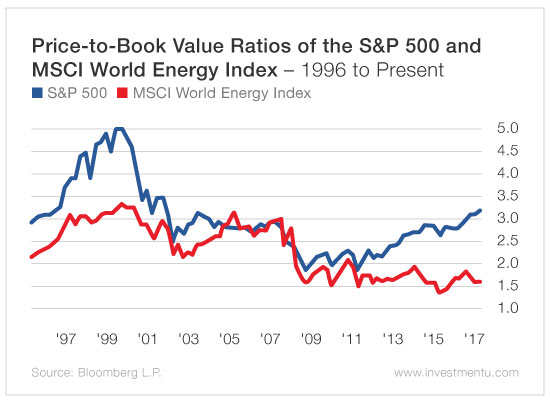
Investing in energy stocks has been a roller-coaster ride over the last three years. The steep drop and slower recovery in crude oil prices has fueled the majority of the volatility.
The price-to-book ratio of the MSCI World Energy Index has fallen to near-record lows. But the S&P 500’s price-to-book ratio continues to climb.
As this week’s chart shows, the energy sector looks cheap.
However, just because it’s cheap, that doesn’t mean the price of every energy stock is going up. Cheapness and value don’t always go hand in hand.
To make money from value investing, you have to know what to look for. You also need to know where to look.
The Definition of a Value Stock
What is a value stock? Value stocks are shares that have been overlooked or ignored by investors. So they are trading at cheap multiples. Value stocks may have some or all of the following characteristics relative to other companies in their respective industries...
- Low price-to-book ratio - compares the stock price to the value of a company’s assets.
- Low price-to-earnings ratio - compares the stock price to its earnings per share.
- Low price-to-sales ratio - compares the market cap to the revenue it has generated over the last year.
- Low price-to-free cash flow - compares the stock price to the amount of money it has on hand.
Of course, just because a stock is cheap, that doesn’t mean it’s a good deal. There could be a reason it’s “on sale.” It could mean that the business is declining. If that’s the case, sales and earnings going forward are going to be much lower than they were in the past.
A Crude Reality for Value Plays
Investors call these companies “value traps.” While their shares may seem attractively priced on the surface, they’re cheap for a very good reason.
In the fall of 2014, many professional investors were buying up energy stocks willy-nilly because they thought the sector’s valuation was too cheap.
Just a few months later, oil prices collapsed. And shares of energy sector companies fell hard and fast with them. These investors saw their stock prices cut in half... or worse.
In early September, a billion-dollar fund manager was pounding the table on oil exploration and production companies. Unfortunately for his investors, his big bet on the energy sector didn’t pay off.
On September 1, 2014, one of his favorite picks, Comstock Resources (NYSE: CRK), was trading at $93.10. Three months later, Comstock Resources had lost nearly two-thirds of its market value. By December 1, 2014, shares were trading at $34.05. Ouch!
Separating the Cheap From the Bad
The key to profitable value investing is knowing the difference between cheap and bad.
True value stocks have defensible businesses, predictable cash flows, reasonable valuations, and reliable and transparent financial statements.
There’s an energy subsector that ticks all of the above value boxes. Weak oil and gas prices severely affected the earnings and cash flows of midstream pipeline companies. U.S. oil exploration and production companies cut back on drilling for “black gold” in response to falling prices.
So the share prices of these pipeline companies have dropped, too. They’ve dropped so much that, from a valuation standpoint, these stocks look cheap.
And their business outlook is improving. As oil and gas producers adjust to the new reality of $50 or even $40 per barrel oil, they are turning up production. More production means that more oil and gas will need to be moved across the country.
Pipeline company revenues, earnings and cash flows are about to head north. And once the market notices, their stock prices will go up as well.
